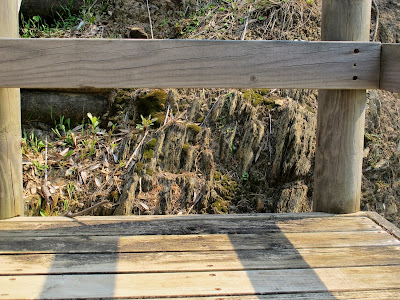But, it seems, this is all natural. The white sandstone was below an ancient water table, the red was above. Inter4esting, but not highly important in my mind.
An unconformity is a gap in the geological record, but before we get to that, a bit about getting there, because the published details in an otherwise very useful leaflet called Ancient sites: a geological journey, left a lot to be desired. Here is my take on it:
On the highway, take the South Durras turn-off about 10 km north of Bateman's Bay: it is well sign-posted. Follow the signs to the Murramarang Resort, ignoring the leaflet.
On the far side of the car park, you come to this sign, which is between two roads. I took the right fork, and that worked. Drive along to the Myrtle Beach/Dark Beach turn-off and drive to the parking area.
The sign below shows you where to go. Follow the path for about 250 metres (leaflet says 200) and look for an unmarked path on the right, going downhill with log "steps".
Close to the beach, you will come to some timber steps. Somebody has written on these that the beach is a nude beach. There was nobody there, so we had no idea whether the sign has any validity and didn't care.
At the bottom of the steps, we turned left (north) and walked along the grassed area at the back of the beach, until we saw this, perhaps 60 metres from the steps. This is it.
It isn't all that obvious, but the beds coming out of the ground are tilted and obviously metamorphic, unlike the rubbly conglomerate just above. Look closer, where Chris is pointing:
And closer again:
And even closer. Her hand is spanning about 150 million years of history, because the old Ordovician rocks were buried deep, metamorphosed by heat and/or pressure, tilted, uplifted, eroded, and then cast down into a deep depressions where new sediments could be deposited, some time in the Permian.
Pretty neat, huh? Chris was neat, too. On the way up, she spotted these tilted beds behind the first landing on the stairs. This reminds us that the base level that the first sediments were dumped into was by no means a level area: these would be 8-10 metres higher than where Chris had placed her hand on the boundary.
Links to the other four parts:
Part 1
Part 2
Part 3
Part 4









No comments:
Post a Comment